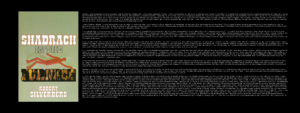Carpentry (spiritual discipline) (nonfiction)
In Robert Silverberg's 1976 novel Shadrach in the Furnace, carpentry is practiced as a spiritual discipline.
Excerpt
Shadrach takes momentary refuge in carpentry. Until now that fashionable cult has been mere amusement for him, a source of relaxation and release rather than the quasi-mystical focus that it is for many of its adherents, but now, frayed and desperate, no longer the calm and detached Shadrach of yore, he surrenders to its full intensity. The world has tightened around him. Ostensibly, all is as it has been, and is not going to change; his routines will continue, his doctoring and his calisthenics and his collecting and his trips to Karakorum; but in these past two days, aware now of the dread subtraction of self that Genghis Mao has covertly ordained for him, Shadrach finds the familiar and comfortable rhythms of life no longer enough to keep him together. Fear and pain have begun to seep into his soul, and the only antidote he knows for that is submission to some force greater than himself, greater even than Genghis Mao, some all-encompassing power. If he can, he will make carpentry the vehicle of that submission. With hammer and nails, then, with chisel and adze, with plane and saw and awl, he seeks, if not salvation, then at least temporary freedom from anguish.
Usually Shadrach attends the large and majestic carpentry chapel in Karakorum. But there is always a carnival atmosphere in Karakorum, and that tends to trivialize whatever he does there, be it carpentry or dream-death or transtemporalism or mere fornication. Now, in genuine spiritual need, he wants not the fanciest chapel but the one most readily accessible, the one that will enable him most quickly to find surcease from pain, and he goes to a place here in Ulan Bator, down by the Tuula River, in one of those streets of formidable blocky white-stucco buildings constructed in the latter days of the Mongolian Peoples Republic.
It is a starkly functional no-nonsense sort of chapel, lacking in any religious or pseudoreligious iconography. Big bare rooms, sputtering fluorescent lights, the smell of sawdust and lemon oil — it could be an ordinary carpenters' shop, but for the silence and the peculiar concentration with which the men and women at the benches are going about their tasks. Shadrach pays a fee at the entrance — strictly a service charge, covering the cost of tool rental, lumber, and maintenance, never a fee for worship itself — and is shown to a locker where he exchanges his street clothes for clean coveralls. Then he selects a vacant bench. Shining well-oiled tools have been arranged along and around it with an eye for symmetry and neatness that is positively Japanese: chisels of many sizes in a precisely ordered row, an assortment of hammers and mallets, a cluster of gauges, augers, pincers, compasses, bevels, files, try squares, and rules. The equipment is deliberately varied and copious, to impress upon the worshipper the hieratic nature of the craft, the ancient lineage of its practice, the complexity of its scope.
No one speaks to him. No one looks at him. No one will; those who enter here must remain alone with their tools and their wood. A strange solemnity steals over him as he makes ready to enter the customary initial stale of meditation. In the past, having come to the chapel for nothing more than a relaxing couple of hours of cutting and joining, seeing the whole experience as an amusement on the same level as a round of golf or a game of billiards, he has approached this stage of the ceremony in a casual and amiable way, accepting it as part of the tradition, something that one does merely to get into the spirit of the thing, the equivalent of a golfer's ritualized practice swings or a billiards player's careful chalking of the cue; but this time, as he presses both hands flat against the workbench and bows his head, he feels neither flippant nor stagily ostentatious; he is aware of a numinous presence all about him, and he grows somber and reflective as it enters his soul.
In the meditation one first must consider the tools, their form and divine essence. One must visualize them and name them: this is a tenon saw, this a dovetail saw, this a gimlet, this a brad-awl. One then must dwell on their purpose, which requires one to imagine each tool in action, and this in turn calls for contemplation of certain basic techniques of carpentry and joinery: the making of mortises and tenons, the construction of joists and frames, the fitting of veneers, the setting of braces and struts and wedging. This phase of the meditation is the most prolonged and the most intense. Shadrach has heard that some adherents to the cult devote the entire energy of their worship to it, and never actually take tools and wood into their hands, but carry out a completely satisfying communion in their minds alone. Until today he has never really understood how this could be accomplished, but now, scribing and mitring and butting as he sits with closed eyes, menially fitting tenon into mortise and tongue into groove, he sees that actual manual labor can be extraneous to this experience if one is able fully to enter into the meditative phase.
He perceives this, but he moves on anyway into the terminal stage of the meditation, which is the entry into the wood, the mother-stuff. This too is a highly structured exercise, which one must begin by imagining trees, not merely any trees but specific timber trees of one's own choice, ordinarily pine or spruce or fir for Shadrach, occasionally more exotic woods, according to his whim, ebony, palisander, mahogany, teak. One must see the tree; one must imagine it felled; one must carry it onward to be milled and seasoned; one must at last behold the finished board, and contemplate its grain, its texture, its moisture content, its vulnerability to shrinkage and warpage, all its characteristics and special beauties. And then, only then, when one can taste the wood on one's tongue, when one feels the tool hot and eager in one's hand, then does one rise and go to the bin and select one's lumber and begin at last to work.
Shadrach knows, by the time he has reached this stage, exactly what the form of his worship will be today. He will do no fancy joinery this day, but simple heavy carpentry, simple but pure, a job that strikes to the essence of form: he will construct the centering for a brick arch. It has sprung entire into his mind, the ribs and ties, the braces and struts, the laggings, the wedges; he has calculated the curvature, the span, the height of the crown, the springing line, all in one rush of inner vision, and now he need only cut and fit and hammer, and when he is done he will disassemble everything, carry out the ceremonial burning of the sawdust, and depart, drained and eased of tension.
He works quickly. A kind of wild feverish energy has come over him. He hastens from bin to bench, from bin to bench; his mouth bristles with nails of half a dozen lengths; he does not pause for an instant. Yet there is nothing rushed about his labor. To rush would be folly; the point here is to attain calmness of spirit. The work should be accomplished swiftly but without haste. Serenely Shadrach builds. The work contains its own purpose and has none beyond the immediate spiritual fulfillment, for one never uses anything one constructs in the carpentry chapel, one never takes anything away that one has put together, any more than one would bring in one’s own tools. This is not a substitute for the home workshop, after all. The idea here is solely to exercise skill in joining, and thus to experience the fundamental connectivity of the universe; what one actually makes is incidental, a means to a higher end, and must not be allowed to become a goal in itself. Shadrach has never fully understood that part of it before today, either. He has enjoyed the physicality of the work, the hammering and the sweat, and he has enjoyed the aesthetic reward, the pleasure of watching something sturdy and attractive take shape under his hands, and he has always felt mildly distressed at the necessary disassembling that follows; because he has never seen the carpentry cult as anything more profound than tennis or golf or bicycle riding, he has never attained those farther reaches of the spirit which he has heard are available to the communicants here. Now he does attain those reaches, at least their nearer fringes, and, penetrating unexpected realms, he finds that his fears and resentments fall away, and he is purified. So it must have been for the Creator, shaping worlds on quiet afternoons, experiencing a total sense of identification with the task, a sense of utter selflessness, of being no more than a conduit for the great shaping force that flows through the universe. No doubt one can just as readily attain the same tranquil place through tennis or golf or bicycle riding, Shadrach realizes. The means is unimportant; only the state of consciousness toward which one journeys matters. He sees his arch acquiring form; it is not his arch but the arch, the prototype of all arches, the ideal arch, the arch on which the vault of the heavens rests, and he and the arch have become one, and he, Shadrach Mordecai of Utan Bator, bears all the weight of the cosmos and feels no burden. Does an arch complain of the load? The arch, if the arch is a proper arch, merely transmits the weight to the earth, and the earth does not complain either, but imparts the thrust of its burden to the stars, which accept it unprotestingly, for there is no burden, there is no weight, there is simply the ebb and flow of substance between the joined members of the one great entity that is the matrix of everything; and when one has perceived that, can it be such a serious matter that one's body, which at the moment houses a pattern of responses that calls itself "Shadrach Mordecai," may soon house instead something calling itself "Genghis Mao"? Such transformations are meaningless. Change does nor occur; there are only transfers, not transformations: the only reality is the reality of eternal flux. He is purged of all discord and all dismay.
In the News
Dubai Hard is a 2021 Emirati-American action-architecture film written and directed by architect Hayri Atak, and starring Bruce Willis as New York City police architectural engineer John McClane (Willis), who gets caught up in an armed interior designer takeover of a rotating turbine-style Dubai skyscraper while visiting his estranged robot spot-welder in a Dubai prison labor camp.
The Courtship of Eddie's Carpenter is an American home improvement psychological thriller television series based on the 1963 "Courtship Carpentry" fad of the same name.
Fiction cross-reference
Nonfiction cross-reference
External links
- Post @ Twitter (2 December 2021)
- Shadrach in the Furnace @ Wikipedia
- Shadrach in the Furnace @ nemaloknig.net


